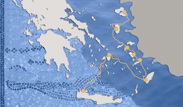The church of the Archangel Michael
The Church of the Archangel
Michael in the village
of Kato Episkopi,
Kissamos, dates to the second half of the 6th century, and is considered the
most important early Christian monument on Crete.
The church is of great archaeological interest from both an architectural and
an artistic point of view. It is the only centrally-planned building
monument on Crete.
The church is of great archaeological interest from both an architectural and
an artistic point of view. It is the only centrally-planned building on Crete, framed by a rectangular ground plan, with a
semi-circular conch flanked by vaulted pastophoria
on Crete, framed by a rectangular ground plan, with a
semi-circular conch flanked by vaulted pastophoria , a domed narthex
, a domed narthex and an atrium
and an atrium . One characteristic feature is the large dome covering the
nave of the church, with stepped concentric hoops on the exterior. The mosaic
floor follows the trends of the time and is decorated with plant motifs (vines,
ivy leaves), ornamental patterns (scales, frames of intersecting circles) and interspersed
animal forms (e.g. fish).
. One characteristic feature is the large dome covering the
nave of the church, with stepped concentric hoops on the exterior. The mosaic
floor follows the trends of the time and is decorated with plant motifs (vines,
ivy leaves), ornamental patterns (scales, frames of intersecting circles) and interspersed
animal forms (e.g. fish).
The four or five layers of frescoes
in the church have only partially survived. The initial layer has been dated to
the 7th century and includes representations of the Ascension and medals of
saints in the dome, as well as a representation of St Matthew in the narthex,
St. George in the southern pastophorio, and the Archangel Michael in the
conch of the sanctuary apse. Parts of frescoes dating to the period of Iconoclasm have been brought to light in the second layer, with nonfigurative
have been brought to light in the second layer, with nonfigurative cross decorations.
The third, mid-Byzantine layer is of high artistic quality, influenced by Comnenian
art in the capital, and is historically linked to the transfer of the Diocese
of Kissamos to the Church of the Archangel Michael during the second Byzantine
period (961 - 1204).
cross decorations.
The third, mid-Byzantine layer is of high artistic quality, influenced by Comnenian
art in the capital, and is historically linked to the transfer of the Diocese
of Kissamos to the Church of the Archangel Michael during the second Byzantine
period (961 - 1204).
Bibliography (3)▼
Comments (0)▼
New Comment▼









